Soluble and insoluble signals and the induction of bone formation: molecular therapeutics recapitulating development
- PMID: 17005018
- PMCID: PMC2100361
- DOI: 10.1111/j.1469-7580.2006.00635.x
Soluble and insoluble signals and the induction of bone formation: molecular therapeutics recapitulating development
Abstract
The osteogenic molecular signals of the transforming growth factor-beta (TGF-beta) superfamily, the bone morphogenetic/osteogenic proteins (BMPs/OPs) and uniquely in primates the TGF-beta isoforms per se, pleiotropic members of the TGF-beta supergene family, induce de novo endochondral bone formation as a recapitulation of embryonic development. Naturally derived BMPs/OPs and gamma-irradiated human recombinant osteogenic protein-1 (hOP-1) delivered by allogeneic and xenogeneic insoluble collagenous matrices initiate de novo bone induction in heterotopic and orthotopic sites of the primate Papio ursinus, culminating in complete calvarial regeneration by day 90 and maintaining the regenerated structures by day 365. The induction of bone by hOP-1 in P. ursinus develops as a mosaic structure with distinct spatial and temporal patterns of gene expression of members of the TGF-beta superfamily that singly, synergistically and synchronously initiate and maintain tissue induction and morphogenesis. The temporal and spatial expressions of TGF-beta1 mRNA indicate a specific temporal transcriptional window during which expression of TGF-beta1 is mandatory for successful and optimal osteogenesis. Highly purified naturally derived bovine BMPs/OPs and hOP-1 delivered by human collagenous bone matrices and porous hydroxyapatite, respectively, induce bone formation in mandibular defects of human patients. By using healthy body sites as bioreactors it is possible to recapitulate embryonic developments by inducing selected biomaterials combined with recombinant proteins to transform into custom-made prefabricated bone grafts for human reconstruction. The osteogenic proteins of the TGF-beta superfamily, BMPs/OPs and TGF-betas, the last endowed with the striking prerogative of inducing endochondral bone formation in primates only, are helping to engineer skeletal reconstruction in molecular terms.
Figures
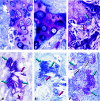
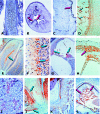
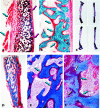

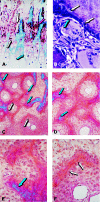



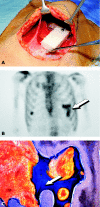

Similar articles
-
Bone morphogenetic proteins in craniofacial and periodontal tissue engineering: experimental studies in the non-human primate Papio ursinus.Cytokine Growth Factor Rev. 2005 Jun;16(3):357-68. doi: 10.1016/j.cytogfr.2005.02.006. Cytokine Growth Factor Rev. 2005. PMID: 15951219 Review.
-
Pleiotropism of bone morphogenetic proteins: from bone induction to cementogenesis and periodontal ligament regeneration.J Int Acad Periodontol. 2006 Jan;8(1):23-32. J Int Acad Periodontol. 2006. PMID: 16459886 Review.
-
Soluble osteogenic molecular signals and the induction of bone formation.Biomaterials. 2006 Feb;27(6):807-22. doi: 10.1016/j.biomaterials.2005.09.021. Epub 2005 Oct 5. Biomaterials. 2006. PMID: 16213014
-
Bone induction by recombinant human osteogenic protein-1 (hOP-1, BMP-7) in the primate Papio ursinus with expression of mRNA of gene products of the TGF-beta superfamily.J Cell Mol Med. 2005 Oct-Dec;9(4):911-28. doi: 10.1111/j.1582-4934.2005.tb00388.x. J Cell Mol Med. 2005. PMID: 16364199 Free PMC article.
-
Bone morphogenetic proteins, cementogenesis, myoblastic stem cells and the induction of periodontal tissue regeneration.Cytokine Growth Factor Rev. 2009 Oct-Dec;20(5-6):489-99. doi: 10.1016/j.cytogfr.2009.10.016. Epub 2009 Nov 7. Cytokine Growth Factor Rev. 2009. PMID: 19897401 Review.
Cited by
-
Low-power ultrasounds as a tool to culture human osteoblasts inside cancellous hydroxyapatite.Bioinorg Chem Appl. 2010;2010:456240. doi: 10.1155/2010/456240. Epub 2010 Mar 31. Bioinorg Chem Appl. 2010. PMID: 20379359 Free PMC article.
-
The induction of endochondral bone formation by transforming growth factor-beta(3): experimental studies in the non-human primate Papio ursinus.J Cell Mol Med. 2008 Jun;12(3):1029-48. doi: 10.1111/j.1582-4934.2008.00126.x. J Cell Mol Med. 2008. PMID: 18494943 Free PMC article.
-
A Macroporous Bioreactor Super Activated by the Recombinant Human Transforming Growth Factor-β(3).Front Physiol. 2012 Jun 7;3:172. doi: 10.3389/fphys.2012.00172. eCollection 2012. Front Physiol. 2012. PMID: 22701102 Free PMC article.
-
Soluble and insoluble signals sculpt osteogenesis in angiogenesis.World J Biol Chem. 2010 May 26;1(5):109-32. doi: 10.4331/wjbc.v1.i5.109. World J Biol Chem. 2010. PMID: 21540997 Free PMC article.
-
COL4A2 in the tissue-specific extracellular matrix plays important role on osteogenic differentiation of periodontal ligament stem cells.Theranostics. 2019 May 31;9(15):4265-4286. doi: 10.7150/thno.35914. eCollection 2019. Theranostics. 2019. PMID: 31285761 Free PMC article.
References
-
- Åberg T, Wozney J, Thesleff I. Expression patterns of bone morphogenetic proteins (Bmps) in the developing mouse tooth suggest roles in morphogenesis and cell differentiation. Dev Dyn. 1997;210:383–396. - PubMed
-
- Bertelsen A. Experimental investigations into post-foetal osteogenesis. Acta Orthop Scand. 1945;15:139–181.
-
- Boyne PJ, Lilly LC, Marx RE, et al. De novo bone induction by recombinant human bone morphogenetic protein-2 (rhBMP-2) in maxillary sinus floor augmentation. J Oral Maxillofac Surg. 2005;63:1693–1707. - PubMed
Publication types
MeSH terms
Substances
LinkOut - more resources
Full Text Sources
Other Literature Sources
Research Materials

